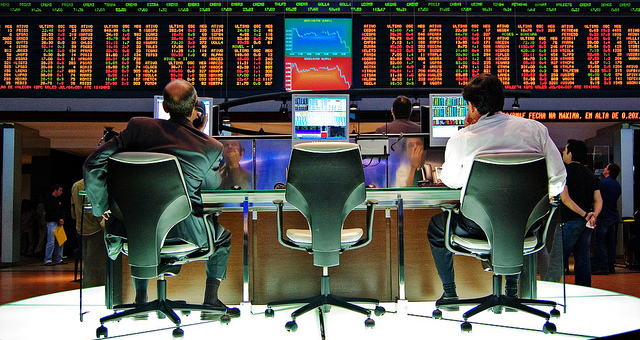It is just like the eternal question every year again – what stocks to buy and what to ignore. The question is simple, but the answer is somewhat complex, as there isn’t any easy and straightforward way to respond to it. Investors can choose however different strategies. Like every year there are always certain companies that will grow no matter what the state of the economy does. These rather save investments are perhaps one of the best strategies to follow. But there are also sectors and industries that will be particularly flourishing in 2015.
Certain stocks have been climbing for four years in a row. Better judgement might suggest that there is an end to it. However, certain companies are simply not giving in. Furthermore, the December sell-off is the perfect opportunity for investors to enter the game. Companies like Apple (APPL) have been trending and created nothing but revenue for investors. The Apple stock has generated profits for five consecutive years and there isn’t any indication that 2015 will be different. The reputation of the company’s iOS operating system is better than ever and iPhones are leading the smartphone market. Apple appears to be a no-brainer.
The same holds for other IT stocks. The social media platform Facebook (FB) has enjoyed a 40% increase in the last year alone. Instagram, which is part of Facebook Inc., just reached 300 million active users and is said to have a vast potential for growth. With potential video ads launching on Instgram this year, the Facebook stock is set to climb further. Next to Apple and Facebook stands another giant, which has similar prospects – Google (GOOGL). The market share of the company is beyond belief and easily surpasses the ones of the competitors. No matter whether mobile phone market, online search or services and applications – the sails are set into one direction. Investing in any of these IT brands could be a risky undertaking considering their extremely long runs up the market ladder, but they are clearly not finished yet. Therefore, any of them should be a save investment for 2015.
However, these are not the only stocks, which are predicted to go up. Many other information technology stocks are said to behave similarly. Even the famous heavyweight Goldman says that investment in this sector will bring favourable profits. The growth predictions for this particular industry are set around 9%. This will ensure decent returns for shareholders.
Another investment tip given by many important financial institutes are the big global stock market indices. At least within the first half of 2015 the major indices are expected to grow. Especially the S&P 500, the American stock market index, is according to the forecast of the financial institute Goldman Sachs continuing to increase in value. Since the crash in 2009, the index has doubled in points and even climbed over the value it has had before the crash. Analysts calculate with at least another 5% increase in the first few months of 2015. Also the TOPIX, the Tokyo Stock Price Index, is on an upward spiral and estimated to be even steeper than the American index. Although the Japanese economy has suffered various setbacks in the last years, the predictions for the second most important Japanese stock market index are positive.
Investments not to make are material stocks. As the Chinese economy is experiencing stagnation, the demand for raw materials is going back. The stocks have increased in the last years, however the prediction for 2015 is dim. Most likely the stocks fall deep before they will increase and stabilise again. One should wait until they fall though. The moment when they will fall is unclear, but the fall itself is almost certain. Once the material stocks have considerably decreased, one should consider investing again.
No matter whether coal, oil or base metal – the price is weak. The oil price hit a five-year low and the coal price even went below its 10-year average. The wheels of the commodity super-cycle seem to be stuck in the sand. With oil and coal having increased up to a ten-fold in the last 15 years, the growth has been cut. China and other emerging nations had been responsible for a massive demand of materials. However, slow economies and decreased demand, especially in China, are now creating the halt.
Although major economies, such as Russia and China, are slowing down for different reasons, the Asian market is expected to grow in 2015. The emerging markets of China and India as well as South Korea and Indonesia are not to be underestimated in the next twelve months. Reforms and different policy chances have reduced bureaucracy and enable so economic growth. Furthermore, through policy changes unproductive and ineffective industries and sectors will be more exposed to the order and self-regulation of the markets. One of the best performers of the Asian markets in 2014 was the Deutsche X-Trackers Harvest CSI 300 China (ASHR), which increased by 47%. The steep trend increased especially in the last two months of the year and is therefore a top contender to watch and invest in for the first few months of the New Year.
While still in trouble is 2013, India and Indonesia have stabilised their currencies in 2014, while Korea, Taiwan and Singapore had suffered compared to the US dollar. This however has helped India and Indonesia to push reforms and growth their own markets. The Indonesian iShares MSCI Indonesia ETF (EIDO) grew by over 21% and the Wisdom Tree India Earnings Fund (EPI) could improve by more than 27%. Both of them can be interesting for investors in the next six months. Although both experience occasional setbacks, one could consider them as a long-term investment, as their potential growth could be up to 20% for the next two years.
In general 2015 isn’t looking bad at all. The US market as well as different Asian markets, such as the Indian and Indonesian markets, are expected to grow further, although some have already been growing too long in the opinion of some analysts. Investing in information technology stocks will be the safest bet though.


